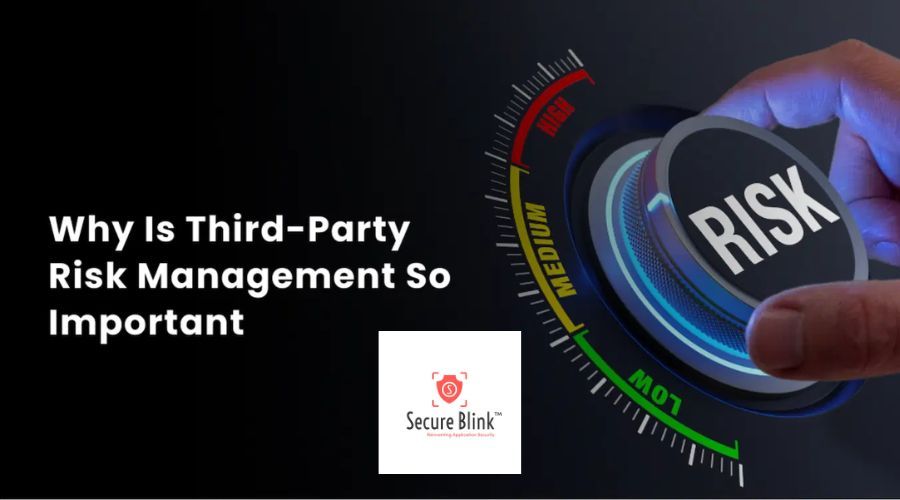Today, businesses rely heavily on networks and external collaborations, and therefore risks associated with third-party vendors have never been more pronounced. Imagine your business as a fortress—strong walls and vigilant guards can protect it, but a single unlocked backdoor could render those defenses useless. That backdoor? Often, it’s the vulnerabilities introduced by third-party vendors. Third-party risk management (TPRM) has therefore evolved from being a nice-to-have process to an indispensable cornerstone of modern business strategy.
Third-party risk management (TPRM) not just important but indispensable for protecting your business. But TPRM isn’t just about avoiding pitfalls; it’s a proactive strategy that enables organizations to build resilience, enhance trust, and drive long-term success.
In this article we will dive into why TPRM is vital and how businesses can harness its power to secure their operations.
Understanding Third-Party Risk Management
Third-party risk management refers to the process of identifying, assessing, and mitigating risks that arise from an organization’s reliance on external vendors or partners. These risks often stem from vulnerabilities in the third-party’s systems, processes, or policies. Common areas of concern include data breaches, operational disruptions, regulatory non-compliance, and reputational damage.
The Importance of Third-Party Risk Management
-
Protecting Sensitive Data Many third-party vendors have access to sensitive organizational data, including customer information, intellectual property, and financial records. A single data breach involving a third party can lead to significant financial and reputational harm.
-
Ensuring Regulatory Compliance Regulatory bodies often hold organizations accountable for the actions of their vendors. For example, the General Data Protection Regulation (GDPR) and the Health Insurance Portability and Accountability Act (HIPAA) require businesses to ensure their third parties adhere to strict data protection standards.
-
Minimizing Operational Disruptions A failure or cyberattack at a critical third-party vendor can disrupt an organization’s supply chain or essential services. Supply chain risk management is therefore a vital component of any TPRM strategy.
-
Preserving Brand Reputation Customers and stakeholders expect organizations to ensure the security and reliability of their operations. Any issues involving third-party vendors can tarnish an organization’s reputation and erode trust.
Third-Party Cybersecurity Risk Management Challenges
While the importance of third-party risk management is undeniable, organizations face several challenges when implementing effective TPRM strategies:
-
Lack of Visibility: Organizations often struggle to gain full visibility into their third-party networks, making it difficult to assess risks accurately.
-
Diverse Vendor Ecosystem: Managing risks across a wide range of vendors with varying levels of cybersecurity maturity can be overwhelming.
-
Evolving Threat Landscape: Cyber threats targeting third parties, such as ransomware and phishing attacks, are becoming increasingly sophisticated.
Third-Party Risk Management Best Practices
To address these challenges, organizations should adopt the following third-party risk management best practices:
-
Establish a Comprehensive Risk Management Framework Develop a TPRM framework that outlines the processes, policies, and tools required to manage third-party risks effectively.
-
Conduct Vendor Risk Assessments Regularly evaluate the cybersecurity posture of your third-party vendors through security questionnaires, audits, and penetration testing. Focus on their vulnerability management practices and incident response capabilities.
-
Implement Third-Party Risk Management Tools Invest in a third-party risk management tool or platform like Cyble that provides real-time visibility into vendor risks. Such tools can automate risk assessments, monitor vendor activities, and generate actionable insights.
-
Enforce Contractual Obligations Include robust security requirements in vendor contracts. Ensure vendors comply with industry standards such as ISO 27001, SOC 2, and NIST Cybersecurity Framework.
-
**Monitor Vendor Performance Continuously **Use a combination of manual reviews and automated monitoring solutions to track vendor performance and identify emerging risks. Third-party risk management services often include continuous monitoring capabilities to ensure ongoing compliance.
-
Strengthen Collaboration Across Teams Foster collaboration between procurement, legal, IT, and cybersecurity teams to ensure a unified approach to managing third-party risks.
Key Strategies for Third-Party Risk Management
Effective TPRM requires a strategic approach tailored to the organization’s specific needs. Here are some third-party risk management strategies to consider:
-
Risk Prioritization: Focus on vendors with access to the most sensitive data or critical systems. Use a risk-based approach to allocate resources efficiently.
-
Supply Chain Risk Management: Assess risks across the entire supply chain to ensure all third-party dependencies are secure.
-
Incident Response Planning: Collaborate with vendors to establish clear protocols for responding to security incidents, including breach notification timelines.
-
Training and Awareness: Educate internal teams and third-party vendors about cybersecurity risks and best practices.
Choosing the Right Third-Party Risk Management Solution
Selecting the right third-party risk management product or platform is crucial for streamlining your TPRM processes. Look for a solution that offers the following features:
-
Automation: Automate vendor risk assessments and continuous monitoring to save time and reduce human error.
-
Integration: Ensure the platform integrates seamlessly with existing tools such as vulnerability management and compliance systems.
-
Customisability: Opt for a solution that can be tailored to meet your organization’s unique needs.
-
Scalability: Choose a platform that can grow with your vendor ecosystem.
-
Expert Support: Consider working with a third-party risk management company that provides additional services such as consulting and risk mitigation.
Secure Your Business from Third-Party Vulnerabilities with Cyble's Third-Party Risk Management Solutions
Cyble’s Third Party Risk Management solutions offers a comprehensive suite of tools designed to identify, assess, and mitigate these risks effectively.
Cyble’s platform leverages advanced analytics and real-time monitoring to deliver actionable insights into vendor vulnerabilities. With capabilities such as automated risk scoring, continuous surveillance of vendor ecosystems, and integration with broader cybersecurity frameworks, Cyble empowers organizations to stay ahead of potential threats. Additionally, the solution helps businesses achieve regulatory compliance by aligning with global standards, ensuring that third-party relationships are both secure and legally sound.
By adopting Cyble’s TPRM solutions, organizations can enhance their cybersecurity posture, protect sensitive data, and ensure business continuity in an increasingly interconnected world.
Benefits of Third-Party Risk Management Services
Engaging professional third-party risk management services can help organizations:
- Gain expert insights into vendor risks and compliance requirements.
- Reduce the time and effort required to manage third-party risks.
- Enhance their overall cybersecurity posture.
Real-World Impacts of Effective TPRM
Organizations that invest in strong TPRM practices reap significant benefits, including:
-
Reduced Breach Incidents: Proactive risk assessments and monitoring reduce the likelihood of third-party breaches.
-
Improved Compliance: Strong TPRM practices ensure alignment with regulatory requirements, avoiding costly fines and penalties.
-
Enhanced Business Continuity: Effective supply chain risk management minimizes disruptions caused by vendor failures.
-
Increased Stakeholder Confidence: Demonstrating a commitment to cybersecurity boosts customer and investor trust.
Final Thoughts
As the old saying goes, “A chain is only as strong as its weakest link.” Third-party risk management isn’t just about managing external threats; it’s about securing your business for the future. As organizations grow more reliant on interconnected ecosystems, the ability to proactively address third-party risks becomes a defining factor for success.
By leveraging advanced third-party risk management (TPRM) solutions, partnering with trusted experts, and adopting comprehensive best practices, businesses can turn potential vulnerabilities into strengths. The stakes are high, but so are the rewards for those who prioritize security, resilience, and trust in their third-party relationships. Remember, in the battle against risk, preparation isn’t optional—it’s essential.







